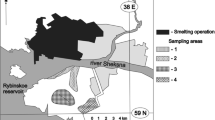Abstract
Bioaccumulation of heavy metals in fauna and flora in the Ijaw area of the Niger Delta of Nigeria were investigated. The fauna-molluscs and Crustacea, and flora Hibiscus esculentus and vernonia amygdalina were selected for this study. Results show that Molluscs and Crustacea accumulate considerable amounts of heavy metals. Higher levels of all the metals determined Hg, Pb, Cr, Cu, Ni, and Zn were observed in the shells than in the fleshly tissues. Hibiscus esculentus and vernonia amygdalina also accumulated these heavy metals. The mercury levels in the roots of Hibiscus esculentus and vernonia amygdalina is 0.010 μg/g ± 0.00, while the stem 0.17 ± 0.03 μg/g and leaves 0.25 ± 0.02μg/g was recorded for the v. amygdalina. The H. esculenta fruit has lead levels of 0.22 ± 0.03 μg/g. The levelsof Cu, Ni, and Zn are generally higher than those of Hg, Pb and Cr in all the samples analyzed. There is a growing concern about the physiological and behavioral effects of environmental trace metals in human population. The toxicity of lead at high levels of exposure is well known but of a major concern is the possibility that continual exposure to relatively low levels of these heavy metals through the consumption of these fauna and flora may entail adverse health effects.
Similar content being viewed by others
References
American Public Health Association (APHA), (1990). Standard Methods for the examination of water and waste water, 17th Ed. NY.
Bergback, B., Anderberg, S., Lohm, U., (1992), Lead load: Historic pattern of lead use in Sweden. Ambio., 21(2), 159–165.
Bower, H.J., (1979). Heavy metals in the sediments of foundary cover cold spring. New York; Environ Sci. Technol., 13, 683–689.
Clark, R.B., Chris, F., Martin, A., (1997). Marine pollution. Claredon Press Oxford Britain, 61–75.
Goyer, RA., (1995). Nutrition and metal toxicity. Am. J. Clin. Nutr., 61, 32–40.
Gustav, R., (1974). Hazardous heavy metals. WHO International Ref. Centre for Waste Disposal (IRCWD News), 6.
Hardy, J.D., (1962), Fluid Therapy 29th Ed., Lee Febiger.
Harper, H.A., (1975), Mineral and water metabolism. In: Review of Physiological Chemistry. 27th Ed. Lauge Medical Publication Canada, 422–444.
Hugget, R.J., Bencher, M.E., Slone, H.D., (1973). Utilizing metal concentration relationships in the eastern oyster (Craostrae virginica) to detect heavy metal pollution. Wat. Res., 7, 151–540.
Koller, K., Brown, T., Spurgeon, A., Levy, L., (2004). Recent development in low level exposure and intellectual impairment in children. Environ. Health Perspect, 112(9), 987–994.
Niger Delta Environmental Survey (NDES), (1999). Phase I Report, Vol. 1. Environmental and Socio-economic characteristic (revised edition).
Perkin-Elmer, N., (1973). Analytical methods for atomic absorption spectrotometry agriculture. Connecticut: Perkin Elmer Norwalck.
Pocock, S.J., Smith, M., Baghurst, P., (1994). Environmental lead and children’s intelligence: A systematic review of the epidemiological evidence. Br. Med. J., 304, 1189–1197.
Hauser, R., Hauser, M., (2002). The dangers of heavy metal. Benutsnews. Natur. Medicine, 1.
Stansell, M.J., Deutsch, H.F., (1965). Metabolism of Trace Elements. S. Biol, Chem. 240: 4306.
SCEP (1971) Report on the study of Critical Environmental Problems (SCEP). Man’s Impact on the global environment. MIT Press, Cambridge Mass.
Tinsley, I.J., (1979). Chemical concepts in pollutants behaviour. J. Willey and Sons Inc. NY.
Warren, I.D., (1981). Contamination of sediments by lead, cadmium, and zinc. A review: Environ, pollut, 2, 401–436.
Wills, J., (2000). A survey of offshore oil field drilling wastes and disposal techniques to reduce the ecological impact of sea dumping. Sakhalin Environ. Watch, 13, 23–29.
Author information
Authors and Affiliations
Corresponding author
Rights and permissions
About this article
Cite this article
Gbaruko, B.C., Friday, O.V. Bioaccumulation of heavy metals in some fauna and flora. Int. J. Environ. Sci. Technol. 4, 197–202 (2007). https://doi.org/10.1007/BF03326274
Received:
Revised:
Accepted:
Published:
Issue Date:
DOI: https://doi.org/10.1007/BF03326274




